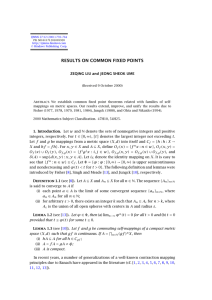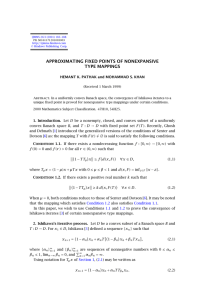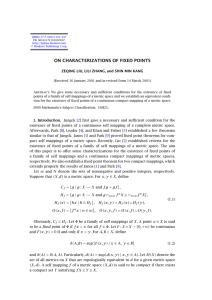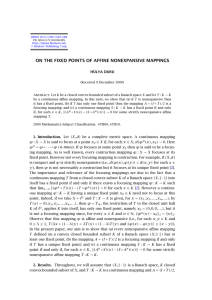Internat. J. Math. & Math. Sci. S0161171200001599 © Hindawi Publishing Corp.
advertisement
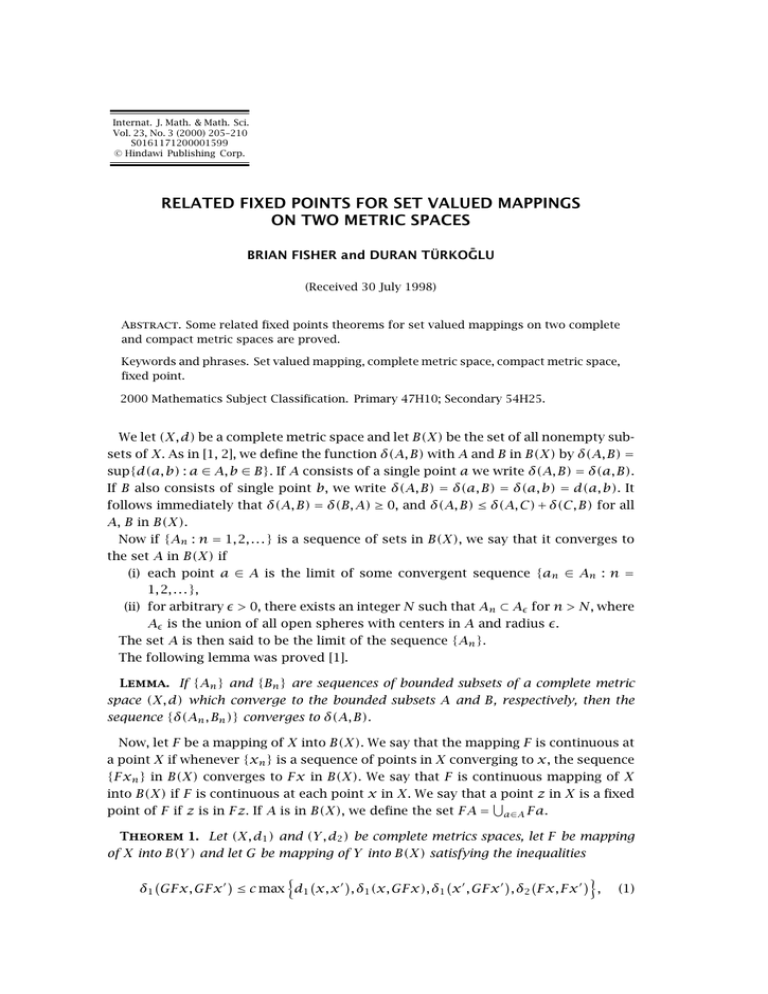
Internat. J. Math. & Math. Sci.
Vol. 23, No. 3 (2000) 205–210
S0161171200001599
© Hindawi Publishing Corp.
RELATED FIXED POINTS FOR SET VALUED MAPPINGS
ON TWO METRIC SPACES
BRIAN FISHER and DURAN TÜRKOḠLU
(Received 30 July 1998)
Abstract. Some related fixed points theorems for set valued mappings on two complete
and compact metric spaces are proved.
Keywords and phrases. Set valued mapping, complete metric space, compact metric space,
fixed point.
2000 Mathematics Subject Classification. Primary 47H10; Secondary 54H25.
We let (X, d) be a complete metric space and let B(X) be the set of all nonempty subsets of X. As in [1, 2], we define the function δ(A, B) with A and B in B(X) by δ(A, B) =
sup{d(a, b) : a ∈ A, b ∈ B}. If A consists of a single point a we write δ(A, B) = δ(a, B).
If B also consists of single point b, we write δ(A, B) = δ(a, B) = δ(a, b) = d(a, b). It
follows immediately that δ(A, B) = δ(B, A) ≥ 0, and δ(A, B) ≤ δ(A, C) + δ(C, B) for all
A, B in B(X).
Now if {An : n = 1, 2, . . . } is a sequence of sets in B(X), we say that it converges to
the set A in B(X) if
(i) each point a ∈ A is the limit of some convergent sequence {an ∈ An : n =
1, 2, . . . },
(ii) for arbitrary > 0, there exists an integer N such that An ⊂ A for n > N, where
A is the union of all open spheres with centers in A and radius .
The set A is then said to be the limit of the sequence {An }.
The following lemma was proved [1].
Lemma. If {An } and {Bn } are sequences of bounded subsets of a complete metric
space (X, d) which converge to the bounded subsets A and B, respectively, then the
sequence {δ(An , Bn )} converges to δ(A, B).
Now, let F be a mapping of X into B(X). We say that the mapping F is continuous at
a point X if whenever {xn } is a sequence of points in X converging to x, the sequence
{F xn } in B(X) converges to F x in B(X). We say that F is continuous mapping of X
into B(X) if F is continuous at each point x in X. We say that a point z in X is a fixed
point of F if z is in F z. If A is in B(X), we define the set F A = a∈A F a.
Theorem 1. Let (X, d1 ) and (Y , d2 ) be complete metrics spaces, let F be mapping
of X into B(Y ) and let G be mapping of Y into B(X) satisfying the inequalities
δ1 GF x, GF x ≤ c max d1 x, x , δ1 (x, GF x), δ1 x , GF x , δ2 F x, F x ,
(1)
206
B. FISHER AND D. TÜRKOḠLU
δ2 F Gy, F Gy ≤ c max d2 y, y , δ2 (y, F Gy), δ1 y , F Gy , δ1 Gy, Gy (2)
for all x, x in X and y, y , where 0 ≤ c < 1. If F is continuous, then GF has a unique
fixed point z in X and F G has a unique fixed point w in Y .
Proof. Let x1 be an arbitrary point in X. Define sequences {xn } and {yn } in X
and Y , respectively, as follows. Choose a point y1 in F x1 and then a point x2 in Gy1 .
In general, having chosen xn in X and yn in Y choose xn+1 in Gyn and then yn+1 in
F xn+1 for n = 1, 2, . . . . Then,
d1 xn+1 , xn+2 ≤ δ1 GF xn , GF xn+1
≤ c max d1 xn , xn+1 , δ1 xn , GF xn , δ1 xn+1 , GF xn ,
δ1 xn+1 , GF xn+1 , δ2 F xn , F xn+1
≤ c max δ1 GF xn−1 , GF xn , δ1 GF xn , GF xn+1 , δ2 F xn , F xn+1
= c max δ1 GF xn−1 , GF xn , δ2 F xn , F xn+1
(3)
and, similarly,
d2 yn+1 , yn+2 ≤ δ2 F Gyn , GF yn+1
≤ c max δ2 F Gyn−1 , F Gyn , δ1 Gyn , Gyn+1 .
It follow that, for r = 1, 2, . . . ,
d1 xn+1 , xn+r +1 ≤ δ1 GF xn , GF xn+r
≤ δ1 GF xn , GF xn+1 + · · · + δ1 GF xn+r −1 , GF xn+r
≤ c n + c n+1 + · · · + c n+r −1 δ1 x1 , GF x1 < (4)
(5)
for n greater than some N, since c < 1. The sequence {xn } is, therefore, a Cauchy
sequence in the complete metric space X and so has a limit z in X. Similarly, the
sequence {yn } is a sequence in complete metric space Y and so has a limit w in Y .
Further
δ1 z, GF xn ≤ d1 z, xm+1 + δ1 xm+1 , GF xn
(6)
≤ d1 z, xm+1 + δ1 GF xm , GF xn ,
since xm+1 ∈ GF xm . Thus, on using inequality (5), we have
δ1 z, GF xn ≤ d1 z, xm+1 + (7)
for m, n ≥ N. Letting m tends to infinity it follows that
δ1 z, GF xn < (8)
for n > N and so
lim GF xn = {z}
n→∞
(9)
since is arbitrary. Similarly,
lim F Gyn = {w} = lim F xn
n→∞
n→∞
(10)
RELATED FIXED POINTS FOR SET VALUED MAPPINGS . . .
207
since xn+1 is in Gyn . Using the continuity of F , we see that
lim F xn = F z = {w}.
n→∞
Using inequality (1), we now have
δ1 GF xn , GF z ≤ c max d1 (xn , z), δ1 xn , GF xn , δ1 (z, GF z), δ2 F z, F xn .
(11)
(12)
Letting n tends to infinity and using (9) and (11), we have
δ1 (z, GF z) ≤ cδ1 (z, GF z).
(13)
Since c < 1, δ1 (z, GF z) = 0 and, so, we must have GF z = {z}, proving that z is a fixed
point of GF .
Further, using (11), we have
F Gw = F GF z = F z = w,
(14)
proving that w is a fixed point of F G.
Now suppose that GF has a second fixed point z . Then using inequalities (1) and
(2), we have
δ1 z , GF z ≤ δ1 GF z , GF z
≤ c max d1 z , z , δ1 z , GF z , δ2 F z , F z
= cδ2 F z , F z ≤ cδ2 F z , F GF z ≤ cδ2 F GF z , F GF z
(15)
≤ c 2 max δ2 F z , F z , δ2 F z , F GF z , δ1 GF z , F Gz
= c 2 δ2 GF z , GF z
and so F z is a singleton and GF z = {z }, since c < 1. Thus,
d1 z, z = δ1 GF z, GF z
≤ c max d1 z, z , δ1 (z, GF z), δ1 z , GF z , δ2 F z, F z
= cd2 F z, F z .
(16)
But
d2 F z, F z ≤ δ2 F GF z, F GF z
≤ c max δ2 F z, F z , δ2 (F z, F GF z), δ2 F z , F GF z , δ1 GF z, GF z
= c max d2 F z, F z , d2 (F z, F z), d2 F z , F z , d1 z, z
= cd1 z, z
(17)
and so
d1 z, z ≤ c 2 d1 z, z .
(18)
Since c < 1, the uniqueness of z follows.
Similarly, w is the unique fixed point of F G. This completes the proof of the
theorem.
208
B. FISHER AND D. TÜRKOḠLU
If we let F be a single valued mapping T of X into Y and G be a single valued mapping
of Y into X, we obtain the following result given in [3].
Corollary 1. Let (X, d1 ) and (Y , d2 ) be complete metric spaces. If T is a continuous
mapping of X into Y , and S is a mapping of Y into X satisfying the inequalities
d1 ST x, ST x ≤ c max d1 x, x , d1 (x, ST x), d1 x , ST x , d2 T x, T x ,
(19)
d2 ST y, ST y ≤ c max d2 y, y , d2 (y, T Sy), d2 y , T Sy , d1 Sy, Sy for all x, x in X and y, y in Y , where 0 ≤ c < 1, then ST has a unique fixed point z
in X and T S has a unique fixed point w in Y . Further T z = w and Sw = z.
Theorem 2. Let (X, d1 ) and (Y , d2 ) be compact metric spaces. If F is a continuous
mapping of X into B(Y ), and G is a continuous mapping of Y into B(X) satisfying the
inequalities
δ1 (GF x, GF x ) < max d1 x, x , δ1 (x, GF x), δ1 x , GF x , δ2 F x, F x ,
(20)
δ2 F Gy, F Gy < max d2 y, y , δ2 y , F Gy , δ2 y , F Gy , δ1 Gy, Gy for all x, x in X and y, y in Y for which the right-hand sides of the inequalities are
positive. Then F G has a unique fixed point z in X and GF has a unique fixed point w
in Y . Further F Gz = {z} and GF w = {w}.
Proof. Let us denote the right-hand side of inequalities (20) by h(x, x ) and
k(y, y ), respectively. First of all suppose that h(x, x ) = 0 for all x, x ∈ X and
k(y, y ) = 0 for all y, y ∈ Y . Define the real-valued function f (x, x ) on X 2 by
δ1 GF x, GF x .
(21)
f x, x =
h x, x Then if (xn , xn
) is an arbitrary sequence in X 2 converning to (x, x ), it follows
from the lemma and the continuity of F and G the sequence {f (xn , xn
)} converges to
f (x, x ). The function f is therefore a continuous function defined on the compact
metric space X 2 and so achieves its maximum value c1 . Because of inequality (9), c1 < 1
and so
δ1 GF x, GF x ≤ c1 max d1 x, x , δ(x, GF x), δ1 x , GF x , δ2 F x, F x (22)
for all x, x in X.
Similarly, there exists c2 < 1 such that
(23)
δ2 F Gy, F Gy ≤ c2 max d2 y, y , δ2 (y, F Gy), δ2 y , F Gy , δ1 Gy, Gy for all y, y in Y . It follows that the conditions of Theorem 2 are satisfied with c =
max{c1 , c2 } and, so, once again there exist z in X and w in Y such that GF z = {z} and
F Gw = {w}.
Now, suppose that h(x, x ) = 0 for some x, x in X. Then GF x = GF x = {x} = {x }
is a singleton {z} and then F z is a singleton {w}. It follows that z is a fixed point of
RELATED FIXED POINTS FOR SET VALUED MAPPINGS . . .
209
GF and GF z = {z}. Further,
F Gw = F GF z = F z = {w}
(24)
and so w is a fixed point of F G.
It follows similarly that if k(y, y ) = 0 for some y, y in Y , then again GF has a fixed
point z and F G has a fixed point w.
Now let us suppose that GF has a second fixed point z in X so that z is in GF z .
Then on using inequalities (20), we have, on assuming that δ2 (F z , F z ) = 0,
δ1 z , GF z ≤ δ1 GF z , GF z
< max d1 z , z , δ1 z , GF z , δ2 F z , F z
= δ2 F z , F z ≤ δ2 F z , F GF z ≤ δ2 F GF z , F GF z
(25)
< max δ2 F z , F z , δ2 F z , F GF z , δ1 GF z , F Gz
= c 2 δ2 GF z , GF z
a contradiction and so F z is a singleton and GF z = {z }. Thus, if z = z
d1 z, z = δ1 GF z, GF z
< max d1 z, z , δ1 (z, GF z), δ1 z , GF z , δ2 F z, F z
= d2 F z, F z .
(26)
But if F z = F z , we have
d2 F z, F z ≤ δ2 F GF z, F GF z
< max δ2 F z, F z , δ2 (F z, F GF z), δ2 F z , F GF z , δ1 GF z, GF z
(27)
= max δ2 F z, F z , d2 (F z, F z), d2 F z , F z , d1 z, z
= d1 z, z
and so
d1 z, z < d1 z, z ,
(28)
a contradiction. The uniqueness of z follows.
Similarly, w is the unique fixed point of F G. This completes the proof of the theorem.
If we let F be a single valued mapping T of X into Y and G be a single valued mapping
of Y into X, we obtain the following result given in [3].
Corollary 2. Let (X, d1 ) and (Y , d2 ) be compact metric spaces. If T is a continuous mapping of Y into X, and S is a continuous mapping of Y into X satisfying the
inequalities
d1 ST x, ST x < max d1 x, x , d1 (x, ST x), d1 x , ST x , d2 T x, T x ,
(29)
d2 T Sy, T Sy < max d2 y, y , d2 (y, T Sy), d2 y , T Sy , d1 Sy, Sy 210
B. FISHER AND D. TÜRKOḠLU
for all x, x in X and y, y in Y for which the right-hand sides of the inequalities are
positive, then ST has a fixed point z in X and T S has a unique fixed point w in Y .
Further, T z = w and Sw = z.
References
[1]
[2]
[3]
B. Fisher, Common fixed points of mappings and set-valued mappings, Rostock. Math. Kolloq. (1981), no. 18, 69–77. MR 83e:54041. Zbl 479.54025.
, Set-valued mappings on metric spaces, Fund. Math. 112 (1981), no. 2, 141–145.
MR 82h:54074. Zbl 456.54009.
, Related fixed points on two metric spaces, Math. Sem. Notes Kobe Univ. 10 (1982),
no. 1, 17–26. MR 83k:54050. Zbl 501.54032.
Fisher: Department of Mathematics and Computer Science, University of Leicester,
Leicester, LE1 7RH, England
E-mail address: fbr@le.ac.uk
Türkoḡlu: Department of Mathematics, Kirikkale University, 71450 Yahşihan,
Kirikkale, Turkey
E-mail address: turkoglu@sinanoglu.kku.edu.tr

